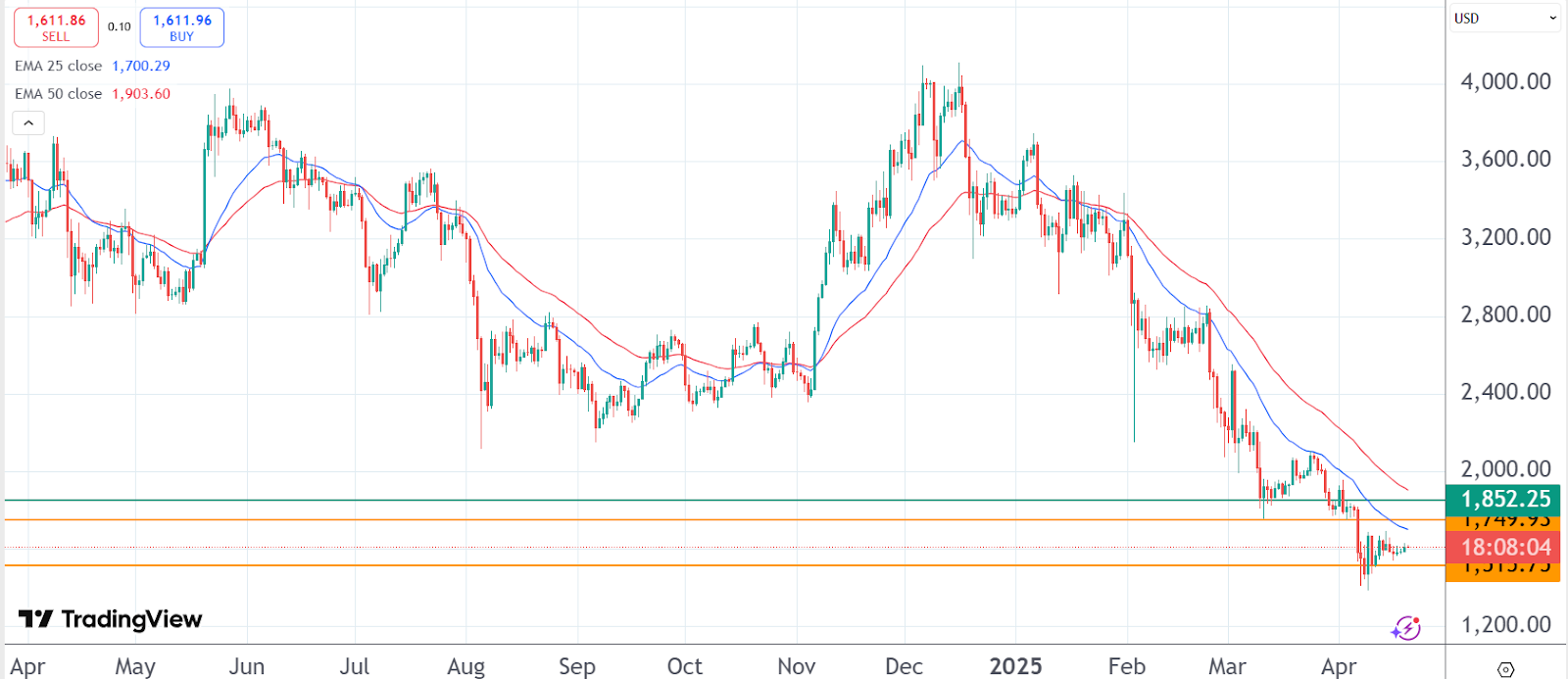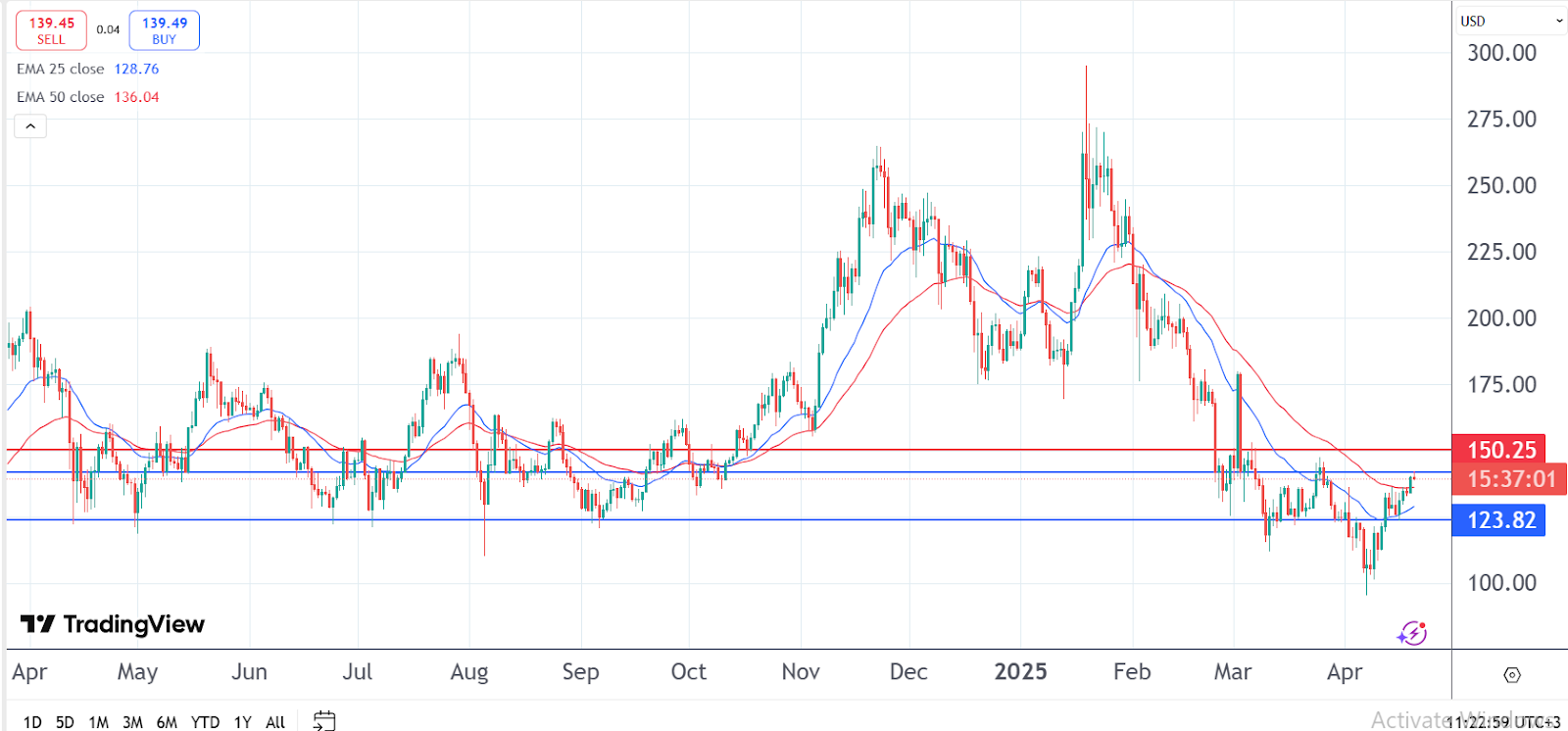
Ethereum steht seit Monaten unter Druck. Trotzdem bauen langfristige Anleger ihre Positionen weiter aus. Neue On-Chain-Daten zeigen: Trotz Buchverlusten kaufen sie gezielt nach.

Finanzmittel Info + Krypto + Geld + Gold
Krypto minen, NFT minten, Gold schürfen und Geld drucken
Ethereum news about the ETH blockchain and its crypto ecosystem.

Ethereum steht seit Monaten unter Druck. Trotzdem bauen langfristige Anleger ihre Positionen weiter aus. Neue On-Chain-Daten zeigen: Trotz Buchverlusten kaufen sie gezielt nach.
US President Donald Trump has signaled a willingness to lower tariffs on Chinese goods.
The announcement comes amid escalating speculation about how such a policy shift could impact inflation, interest rates, and digital assets like Bitcoin and Ethereum.
Trump’s comments have already sparked renewed interest among crypto investors, who see a potential rally in the making.
Speaking in a recent CNBC interview, President Trump acknowledged that the existing 145% US tariff on Chinese imports is “too high” and has effectively crippled bilateral trade.
“At some point, I’m going to lower them,” he said, adding that China is eager to resume business with the United States.
Trump’s remarks suggest that trade talks between the two global powers could be back on the table, with hopes of a more balanced economic relationship.
Currently, the US and China are locked in a steep tariff battle, with Beijing retaliating by imposing a 125% duty on American goods.
These tit-for-tat tariffs have disrupted global supply chains and contributed to higher prices for consumer goods ranging from electronics to clothing.
Industry analysts believe that easing these levies could reduce inflationary pressure, thereby influencing the Federal Reserve’s monetary policy, particularly in holding back further interest rate hikes.
From a crypto market perspective, the implications are significant.
Historically, digital assets such as Bitcoin and Ethereum have shown strong performance during periods of dovish monetary policy and reduced inflation.
With tariff reduction on the horizon, crypto investors are betting on a resurgence in prices.
Bitcoin, for instance, recently dipped below $80,000 but has since bounced back, trading above $94,000 at press time.
Analysts predict that if sentiment continues to improve, Bitcoin could breach the $100,000 milestone, triggering a broader market rally.
Beyond Bitcoin, altcoins like Ethereum (ETH), Ripple (XRP), and Solana (SOL) also stand to gain from a more favorable economic environment.
Reduced trade tension often translates to increased risk appetite, driving more capital into speculative assets like cryptocurrencies.
Trump’s comments also hint at a broader economic recalibration.
Lower tariffs could ease operational costs for American businesses and improve consumer sentiment, factors that indirectly feed into the crypto economy by increasing liquidity and investor confidence.
While a final decision is yet to be made, the mere prospect of US–China trade normalization has already set the tone for a volatile yet potentially bullish phase in the crypto markets.
As always, traders are advised to keep a close eye on policy shifts that could influence macroeconomic indicators and, by extension, digital asset prices.
The post Trump hints at China tariff cut: will Bitcoin price soar past $100K as trade tensions ease? appeared first on CoinJournal.
Fear remains the key emotion in the cryptocurrency space; an aspect that has been weighing on most majors and meme coins. For instance, coupled with its internal challenges, the risk-off mood has Ethereum price still trading below the short and medium-term MAs. However, steady investor confidence has benefited Bitcoin and Solana.
At the same time, savvy investors are looking for opportunities in new crypto projects. As the first Bitcoin meme ICO, Bitcoin Pepe is one of the new entrants that have captured investors’ attention. It seeks to bring the meme culture home to the stable Bitcoin network; assuring meme lovers of a reliable platform, lower fees, and Solana-style transaction speed.
Ethereum’s underwhelming performance remains a concern for many crypto enthusiasts. The leading altcoin tends to mirror Bitcoin’s price movements. However, as the leading cryptocurrency strives for recovery, Ethereum price continues to trade below the short and medium-term MAs of 25 and 50 days.
What’s more, a decline in its Open Interest (OI) and spot Ethereum ETFs’ net inflows point to low investor interest. This is especially since high institutional demand has been a major part of Ether’s appeal in the past.
Data released by SoSoValue showed zero net inflows in Thursday’s session. Indeed, the top 9 spot ETH ETFs all recorded zero flows. Since the beginning of April, there has been a string of outflows with only one session of inflows and another of zero flows.
Besides, at the current $18.26 billion, its OI is significantly below its peak of $32.3 billion in late January. As a performance metric, OI tracks an asset’s options and futures contracts to highlight investor participation.
As seen on its daily price chart, Ethereum price will likely remain range-bound between the support zone of $1,515 and the crucial support-turn-resistance zone of $1,750. Even with further rebounding, the altcoin will likely remain below $1,850 in the short term.

As the world’s first Bitcoin meme ICO, Bitcoin Pepe has created the much-awaited bridge between the world of meme coins and the stable Bitcoin network. Indeed, it is this one-of-a-kind merge that has fueled the project’s virality even before hitting the public shelves.
In the first 10 weeks of its presale, the project has raised over $6.8 million. Besides, 8 out of the total 30 stages have been sold out; securing 40.5% in gains for the early adopters.
By the end of the presale in Q2, long-term holders will have up to 311.4% in cumulative gains. Furthermore, through its mission of “building Solana on Bitcoin”, the project is expected to deliver more gains after its launch. Hurry up and buy Bitcoin Pepe here.

Solana has grown to be a leading blockchain, playing a significant role in NFT and DeFi ecosystems. Despite the persistent macroeconomic uncertainties, it is one of the top-performing majors as investors remain confident in its potential.
A look at its daily chart shows the altcoin trading above the 25 and 50-day EMAs as it records steady recovery. In the immediate term, the range between $123.82 and the current resistance zone of $141.88 is worth watching. With the entry of more buyers, the bulls may have an opportunity to break the resistance to the next target at $150.25.
The post Ethereum stalls, Solana rises as Bitcoin Pepe gains steam appeared first on CoinJournal.
The global cryptocurrency market started 2025 with optimism, fuelled by expectations of favourable policy shifts under Donald Trump’s presidency and a strong rally across meme coins.
But those hopes have since been dashed. According to CoinGecko’s latest quarterly report, crypto’s total market capitalisation fell 18.6% in Q1 2025, wiping out $633.5 billion in value.
Trading volumes also took a hit. The report shows that average daily trading volume fell 27.3% compared to the previous quarter. Spot trading on centralised exchanges declined 16.3%, a drop that was partly attributed to the Bybit hack earlier this year.
Despite signs of strength in early January, recession concerns and fragmented investor interest led to a broad sell-off across digital assets.
Bitcoin retained its dominance over the broader market in Q1, accounting for 59.1% of the total crypto market cap — its highest level since 2021.
This shift highlights how investors have treated Bitcoin as a relatively more stable asset compared to altcoins during uncertain periods.
However, Bitcoin itself was not immune to losses. It declined 11.8% during the quarter and underperformed traditional safe havens like gold and US Treasury bonds.
The report also noted that Trump’s newly imposed tariffs triggered volatility in the bond market, impacting yields — a key metric closely linked to digital asset flows.
Ethereum saw an even sharper reversal. It gave up all of its 2024 gains, returning to levels last seen before its Shanghai upgrade. The report attributed this trend to declining decentralised finance (DeFi) activity and persistent concerns around gas fees and scalability.
Multichain DeFi protocols suffered significantly, with total value locked (TVL) falling 27.5% over the three-month period.
Solana, which led the decentralised exchange (DEX) trading space during the meme coin frenzy in January, saw its own TVL drop by more than 20%.
CoinGecko’s data indicates that market excitement around Trump-themed tokens, particularly the TRUMP coin on Solana, sparked a temporary spike in transaction volumes. However, this activity failed to sustain investor interest beyond January.
The LIBRA scandal, which emerged shortly after, added further pressure on altcoin sentiment and liquidity.
Despite these setbacks, Bitcoin exchange-traded funds (ETFs) recorded $1 billion in fresh inflows in Q1.
But the total assets under management (AUM) across these ETFs still fell by nearly $9 billion due to declining prices, highlighting the gap between investment inflows and market returns.
While some data points suggested limited resilience, nearly every positive trend in the report was accompanied by a downside risk.
The report shows that centralised exchanges, stablecoin volumes, and DeFi applications all registered lower activity in February and March. Many projects lost traction as macroeconomic concerns mounted and investor caution grew.
CoinGecko noted that the first quarter of 2025 represents one of the most challenging periods for crypto since the FTX collapse in late 2022.
The report reflects broader market concerns that the crypto sector, despite structural improvements in infrastructure and compliance, remains deeply vulnerable to global economic shocks.
As recession fears take hold and regulatory uncertainties continue to loom in major markets, the path forward for crypto in the coming months remains highly uncertain.
Although Bitcoin’s rising market share signals a flight to perceived safety, the broader market may need more than optimism and meme coin rallies to recover from this quarter’s losses.
The post Crypto market sheds $633.5B in Q1 2025 as Trump rally momentum fades appeared first on CoinJournal.
Panama City is set to become one of the first Latin American capitals to formally integrate crypto payments into its municipal system, allowing residents to pay for public services in Bitcoin, Ethereum, and stablecoins.
This move, driven by the city’s administration and not national legislation, marks a notable shift in how governments are embracing digital assets.
Panama City Mayor Mayer Mizrachi confirmed the development via a post on X (formerly Twitter) on Wednesday.
He stated that locals will be allowed to settle payments for taxes, permits, traffic tickets, and other municipal fees using cryptocurrencies such as Bitcoin, Ethereum, USDC, and Tether (USDT).
This step was made possible through a council-approved proposal and will be implemented in collaboration with banks that can receive and convert crypto to fiat currency.
The new law gives local residents the option to use select cryptocurrencies instead of fiat money to meet their obligations to city hall.
The digital assets initially accepted include Bitcoin, Ethereum, USDC, and USDT, which have become widely adopted across both retail and institutional ecosystems.
Unlike previous efforts that attempted to implement crypto usage through national-level legislation, Panama City’s government found a way to bypass this hurdle by focusing on local regulation.
Mizrachi explained that earlier governments tried to push similar measures through Panama’s senate, but his administration opted for a simpler legal workaround that avoided introducing entirely new laws.
So far, there has been no official confirmation on whether other cryptocurrencies will be accepted in the future. A city representative did not immediately respond to media enquiries about the possible expansion of the asset list.
In order to operationalise this system, the city will rely on partnerships with banks that are technically capable of receiving digital assets and converting them to fiat.
This model allows Panama City to remain in line with national financial regulations while also giving residents the freedom to transact in crypto.
By allowing local banks to act as intermediaries, the city is aiming to balance innovation with compliance. The measure is expected to support wider crypto adoption in Panama without putting pressure on the central government to introduce sweeping policy changes.
Panama City’s move reflects a broader shift across the region and beyond as governments begin to accommodate digital asset payments.
In 2021, El Salvador became the first country in the world to adopt Bitcoin as legal tender, followed by the Central African Republic the following year. Other countries such as Fiji and Tonga have also considered recognising Bitcoin as an official currency.
In Switzerland, municipalities like Zug and Lugano have already enabled payments for local services using cryptocurrencies. Zug has earned the nickname “Crypto Valley” for its openness to blockchain technology and favourable regulatory environment.
Panama, by contrast, has had a mixed relationship with crypto. In 2022, Panamanian President Laurentino Cortizo partially vetoed a bill that aimed to regulate cryptocurrencies and legalise decentralised autonomous organisations (DAOs).
At the time, the president cited concerns that the bill was not fully aligned with existing financial system norms.
Despite this national-level setback, Panama City’s latest move highlights how local governments can still proceed with adoption in specific areas such as public service payments.
While Panama City is still in the early stages of implementation, its approach could serve as a model for other urban centres looking to embrace crypto without overhauling national law.
By partnering with compliant financial institutions, the city hopes to provide a secure and legally sound way for citizens to use their digital assets in everyday transactions.
Whether this local strategy can scale remains to be seen. But it underscores the growing influence of cryptocurrencies in mainstream economic infrastructure—not just as speculative assets, but as tools for public finance.
The post Panama City joins global move to allow crypto payments in public sector appeared first on CoinJournal.